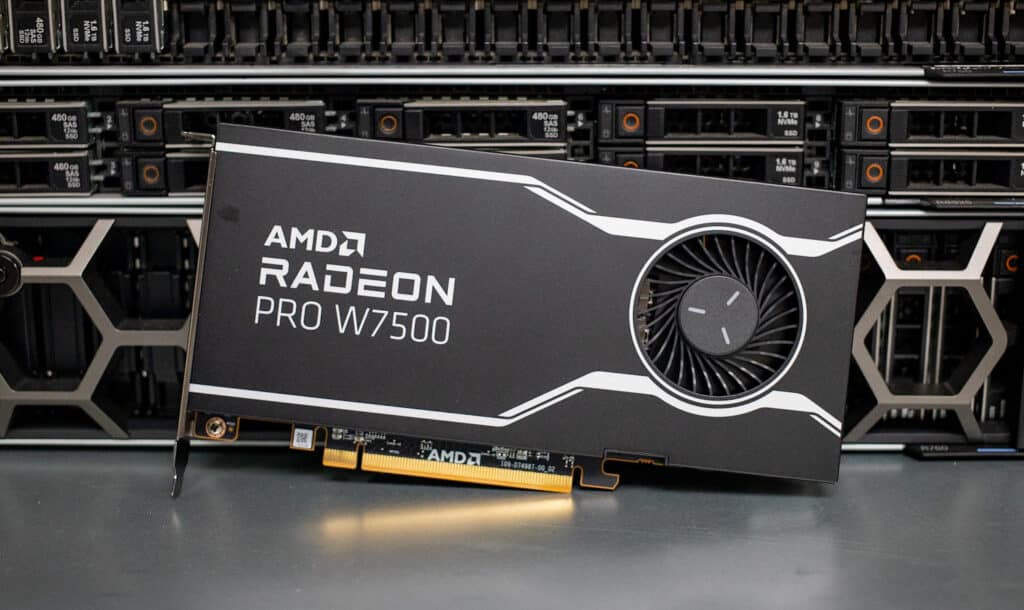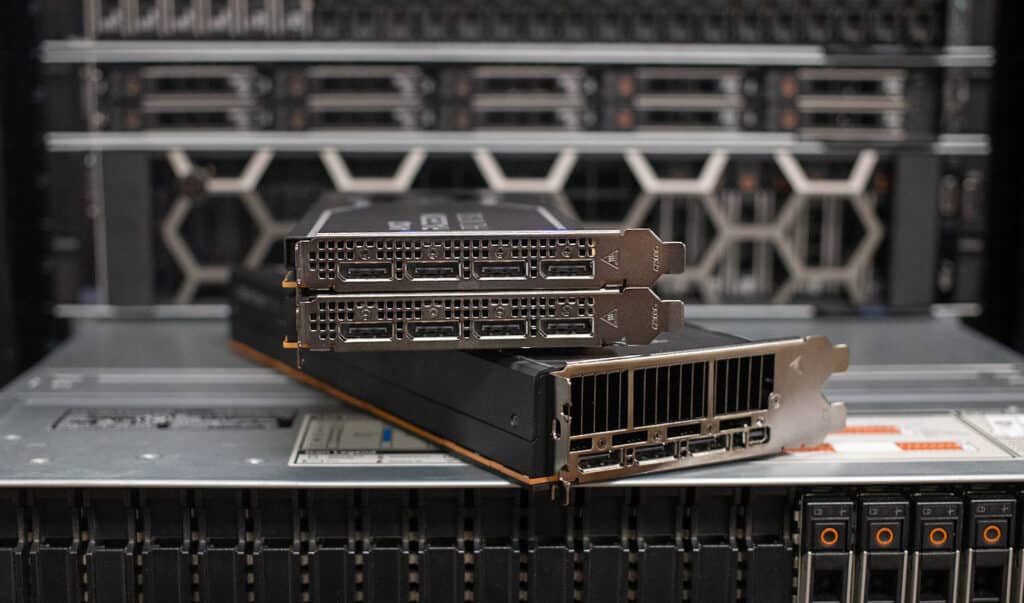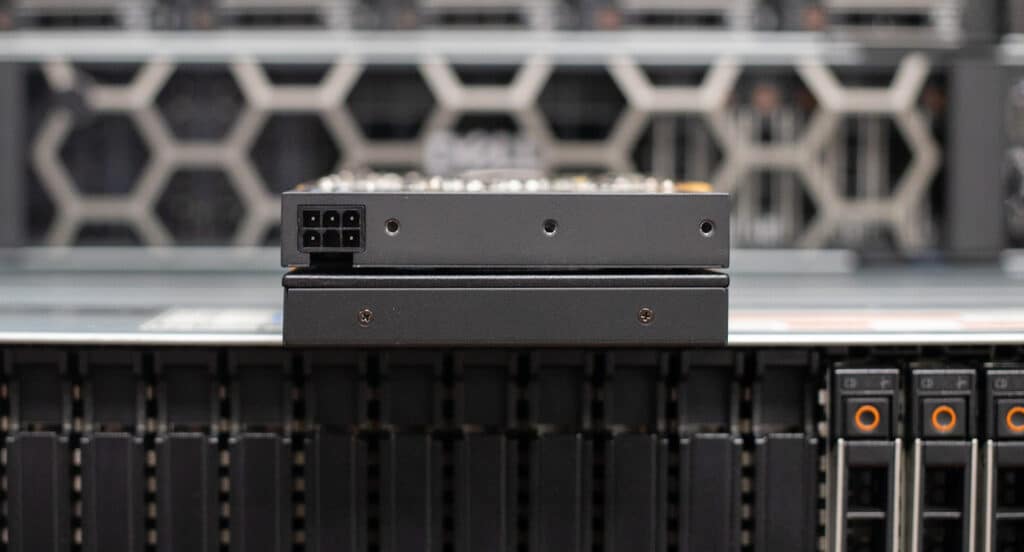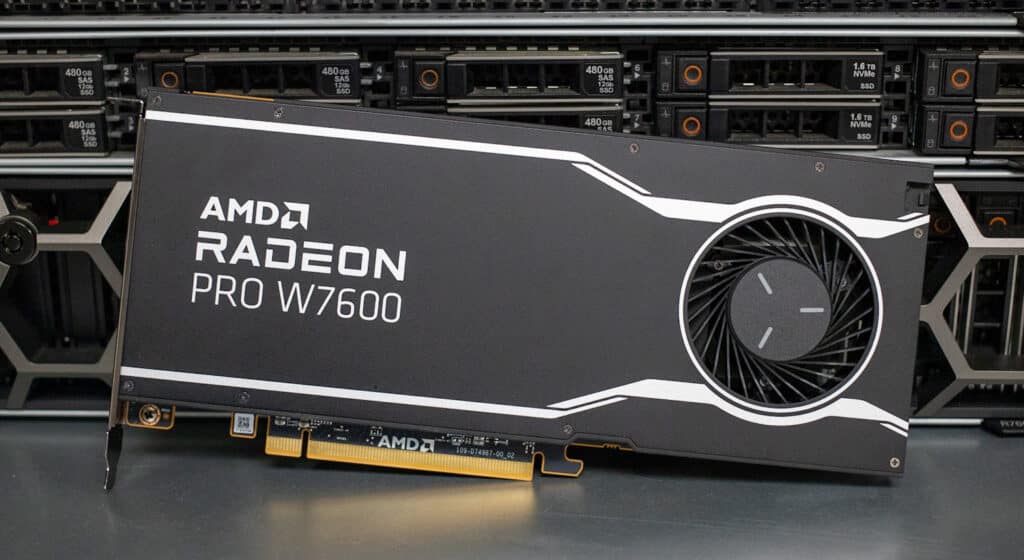The Radeon Pro W7500 and W7600 GPUs are part of AMD’s newest professional graphics series, catering to a more budget-conscious audience. Unlike their higher-end counterparts, the W7900 and W7800 GPUs, these newer models scale back on premium specifications to balance cost and performance.
The Radeon Pro W7500 and W7600 GPUs are part of AMD’s newest professional graphics series, catering to a more budget-conscious audience. Unlike their higher-end counterparts, the W7900 and W7800 GPUs, these newer models scale back on premium specifications to balance cost and performance.
The Radeon Pro W7500 is equipped with 70W Total Board Power (TBP), 8GB GDDR6 memory, and 12 TFLOPS FP32 single precision performance to provide decent compute capability. The Radeon Pro W7600 steps up the performance at the expense of higher power consumption, with a TBP of 130W.
Sporting similar memory specs as the W7500, the W7600 distinguishes itself with better ray tracing performance per Compute Unit (CU) and 20 TFLOPS FP32 single precision performance. Both cards feature a chiplet architecture and DisplayPort 2.1 support, which means more flexibility in design and enhanced display capabilities for higher resolutions and refresh rates.
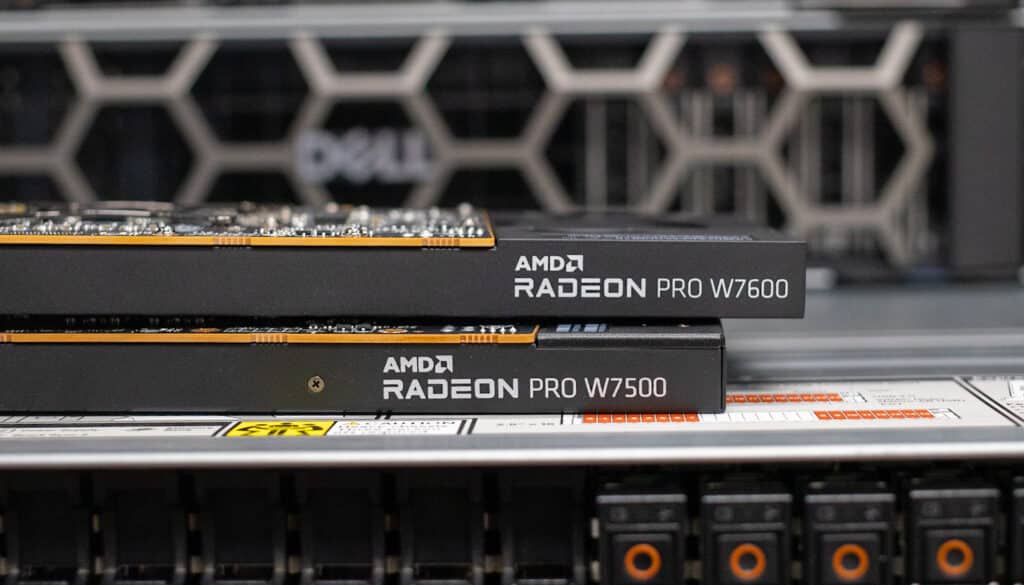
In this combined review, we delve into the specifications and performance differentiators of AMD’s Radeon Pro W7500 and W7600 and put them through our usual GPU benchmarking tests. These models share the same architectural foundation, AMD’s RDNA 3, introducing hardware ray tracing capabilities for enhanced realism in graphical rendering.
AMD Radeon Pro W7600 vs. W6600
The AMD Radeon Pro W7600 succeeds the W6600 with noticeable advancements, incorporating 32 ray accelerators on the innovative RDNA 3 architecture. With 2048 stream processors and a peak memory bandwidth of up to 288GB/s, the W7600 enhances computational power alongside a generous 8GB GDDR6 memory and 32MB AMD Infinity Cache. It also features DisplayPort 2.1, which easily supports 4K, 5K, and 8K. In comparison, the W6600 houses 1792 stream processors, 8 GB GDDR6 memory with a 128-bit interface, and a memory bandwidth of 224 GB/s.
RDNA 3 introduces advanced ray tracing accelerators in its new W7000 lineup, which enables a smoother multimedia performance experience—particularly at high resolutions—than its predecessor. Specifically, the compute units come with integrated “AI Accelerators,” which are expected to enhance the efficiency of data inference tasks. RDNA 3 also incorporates hardware-based acceleration for AV1 encoding at resolutions as high as 8K60. Additionally, it can handle two concurrent streams for encoding or decoding, supporting both AVC and HEVC formats.
AMD Radeon Pro W7600 vs. AMD Radeon Pro W7500
The Radeon Pro W7500 and W7600 have subtle and noticeable variations in their core specifications. The W7500 features 28 Ray Accelerators, 64 ROPs, 1792 Stream Processors, and 28 Compute Units, each with 64 Shaders. In terms of computational performance, it achieves a peak half precision (FP16) performance of 24.38 TFLOPS and a peak single precision (FP32) performance of 12.19 TFLOPS.
Comparatively, the W7600 boosts its specs with 32 Ray Accelerators, 2048 Stream Processors, and 32 Compute Units. Despite the increase in specs, its peak half-precision performance is notably higher at 39.98 TFLOPS, while its peak single-precision performance is reduced slightly to 19.99 TFLOPS.
As indicated above, both GPUs are equipped with 8GB of GDDR6 memory, connected through a 128-bit memory interface. The W7600, however, has a significant memory speed advantage with 18 Gbps compared to the W7500’s 10.8 Gbps. This results in a noticeable peak memory bandwidth increase for the W7600, reaching up to 288GB/s, which likely has implications for memory-intensive workloads.
Another noticeable difference is in the power domain. The Radeon Pro W7500 holds a clear advantage in power efficiency, with a Total Board Power (TBP) of 70W. This lower power consumption could be particularly appealing to users seeking a better balance between performance and energy efficiency. In contrast, the Radeon Pro W7600 exhibits a higher TBP of 130W; however, this reflects its more performance-driven nature—something that many organizations lean towards over power efficiency savings. Users may also need to weigh this power demand against their system’s cooling capabilities and available power supplies within their workstations.
Both GPUs maintain identical display configurations, offering support for up to four DisplayPort (DP 2.1) connections at resolutions ranging from 4K to 8K. The new W7000 Series is the first to support DisplayPort 2.1, providing 54Gbps of bandwidth. This is a big leap from the RDNA 2 cards, which only support up to DisplayPort 1.4’s bandwidth.
Here is a quick rundown of display support:
- 4 monitors/displays @ 3840x2160px (4K)
- 4 monitors/displays @ 5120x2880px (5K)
- 2 monitors/displays @ 7680x4320px (8K)
In terms of form factor, they both leverage single-slot widths. The W7600 is slightly longer, measuring 9.5 inches compared to the W7500’s 8.5 inches, which could impact compatibility within certain chassis.
Backed by a limited 3-Year manufacturer warranty, the Radeon PRO W7500 and W7500 are priced at $429 and $600, respectively.
AMD Radeon Pro W7500 and W7600 Specifications
| Specification | AMD Radeon Pro W7500 | AMD Radeon Pro W7600 |
| GPU Architecture | AMD RDNA 3 | AMD RDNA 3 |
| Hardware Ray Tracing | Yes | Yes |
| Lithography | TSMC 6NM | TSMC 6NM |
| Ray Accelerators | 28 | 32 |
| ROPs | 64 | 64 |
| Stream Processors | 1792 | 2048 |
| Compute Units | 28 | 32 |
| Shaders | 64 | 64 |
| Peak Half Precision (FP16) Performance | 24.38 TFLOPS | 39.98 TFLOPS |
| Peak Single Precision (FP32) Performance | 12.19 TFLOPS | 19.99 TFLOPS |
| Peak Double Precision (FP64) Performance | 0.38 TFLOPS | 0.62 TFLOPS |
| Transistor Count | 13.3 Billion | 13.3 Billion |
| Total Board Power (TBP) | 70W | 130 W |
| PSU Recommendation | 450W | 500W |
| Dedicated Memory Size | 8 GB | 8 GB |
| Memory Speed | 11 Gbps | 18 Gbps |
| Dedicated Memory Type | GDDR6 | GDDR6 |
| AMD Infinity Cache | Yes, 32 MB | Yes, 32 MB |
| Memory Interface | 128-bit | 128-bit |
| Peak Memory Bandwidth | up to 173 GB/s | up to 288 GB/s |
| Memory ECC Support | No | No |
| 4K H264 Encode | Decode | Yes | Yes | Yes | Yes |
| H265/HEVC Encode | Decode | Yes | Yes | Yes | Yes |
| AV1 Encode | Decode | Yes | Yes | Yes | Yes |
| 3D Stereo Support | Yes | Yes |
| Form Factor | PCIe Add-in Card | PCIe Add-in Card |
| Bus Type | PCIe 4.0 x8 | PCIe 4.0 x8 |
| Cooling | Active | Active |
| Displays Type(s) | DisplayPort: 4x DP 2.1 | DisplayPort: 4x DP 2.1 |
| Display Configurations | 4x @ 3840x2160px (4K) 4x @ 5120x2880px (5K) 2x @ 7680x4320px (8K) |
4x @ 3840x2160px (4K) 4x @ 5120x2880px (5K) 2x @ 7680x4320px (8K) |
| HDR Support | Yes | Yes |
| 8K Support | Yes | Yes |
| 16K Support | No | No |
| Board Height | Full Height | Full Height |
| Board Length | 8.5” (216 mm) | 9.5” (241 mm) |
| Board Width | Single Slot | Single Slot |
| Supported Technologies | • AMD Remote Workstation • AMD Radeon Media Engine AMD Software: PRO Edition • AMD Radeon VR Ready Creator • AMD EyefinityTechnology (Professionals) • AMD Radeon ProRender |
• AMD Remote Workstation • AMD Radeon Media Engine AMD Software: PRO Edition • AMD Radeon VR Ready Creator • AMD EyefinityTechnology (Professionals) • AMD Radeon ProRender |
| Software API Support | • DirectX 12 Ultimate • OpenGL 4.6 • Vulkan 1.3.2xx • Open CL 2.0 |
• DirectX 12 Ultimate • OpenGL 4.6 • Vulkan 1.3.2xx • Open CL 2.0 |
| Product Family | AMD Radeon PRO | AMD Radeon PRO |
| Product Line | AMD Radeon PRO W7000 Series | AMD Radeon PRO W7000 Series |
| Platform | Desktop Workstation | Desktop Workstation |
| Supported Operating Systems | • Windows 11 – 64-Bit Edition • Windows 10 – 64-Bit Edition • Linux x86_64 |
• Windows 11 – 64-Bit Edition • Windows 10 – 64-Bit Edition • Linux x86_64 |
| External Power Connectors | None (PCIe Power) | 1×6-Pin Power Connectors |
AMD Radeon PRO W7500 and W7600 Design and Build
The AMD Radeon PRO W7500 and W7600 are designed for professional workstations, meaning they won’t feature flashy RGB lighting or elaborate cooling solutions. It’s important to reiterate that the W7600 is slightly longer than the W7500 at 9.5 inches (241 mm), with the latter coming in at 8.5 inches (216 mm). The W7600 sports a blower-style cooler, ideal for workstation airflow, with all cooling exhaust exiting the back of the card.
Both cards are single-slot full-height form factor. The W7500 does not require any further power (besides connecting it to the PCIe Gen4 slot). However, the W7600 uses the traditional 1×6-Pin power connector due to the card’s more performance-driven architecture. AMD recommends a minimum 450- and 500-watt power supply for the W7500 and W7600, respectively.
Turning the cards over, there are no real intricate design elements you often find on gaming-driven GPUs. These are workstation cards that prioritize functionality over style. So apart from the basic branding on the front of the GPU, the visual design remains understated.
AMD Radeon PRO W7900 and W7800 Performance
Using our internally-built StorageReview test rig for performance testing, the desktop is configured as follows:
- Intel Core i9-12900K CPU w/ liquid cooling
- Asus ROG Strix Z690-E Gaming WiFi motherboard
- Microsoft Windows 11
- 32GB of Kingston Fury DDR5-5200 RAM (2x 16GB)
- Seagate FireCuda 530 2TB SSD
This configuration isn’t a conventional workstation as it doesn’t use a workstation/server-grade CPU. However, it does support PCIe 4.0, which is crucial considering the substantial bandwidth demanded by these modern graphics cards.
In our benchmarking analysis below, we’re pitting the two Radeon PRO cards against the higher-end models (the recently reviewed W7800 and W7900); it serves as a reliable basis for comparison and will demonstrate how these mid-range models compare. This will allow customers to choose the card that best suits their performance needs.
Note that we ran all tests with our monitor resolution set to 4K/UHD.
UL Labs Procyon AI Benchmark
Featuring an array of Artificial Intelligence inference engines from top-tier vendors, the UL Procyon AI Inference Benchmark caters to a broad spectrum of hardware setups and requirements. The benchmark score provides a convenient and standardized summary of on-device inferencing performance. This enables us to compare and contrast different hardware setups in real-world situations without requiring in-house solutions.
| Test | W7500 Windows AI |
W7600 Windows AI |
W7800 Windows AI |
W7900 Windows AI |
| Overall Score | 345 | 463 | 729 | 846 |
| MobileNet V3 Avg. Inference Time | 1.01 | 0.96 | 0.48 | 0.46 |
| ResNet 50 Avg. Inference Time | 4.38 | 3.09 | 2.14 | 1.60 |
| Inception V4 Avg. Inference Time | 13.57 | 9.62 | 7.44 | 6.65 |
| DeepLab V3 Avg. Inference Time | 32.31 | 28.92 | 17.63 | 15.50 |
| YOLO V3 Avg. Inference Time | 15.70 | 10.17 | 8.39 | 6.92 |
| REAL-ESRGAN Avg. Inference Time | 300.93 | 188.86 | 92.22 | 80.74 |
We selected the Windows AI test and compared the new W7500 and W7600 to the recently reviewed, higher-end W7900 and W7800, where you can gauge the performance differences between the models.
SPECviewperf2020
The SPECviewperf 2020 benchmark is the worldwide standard for measuring graphics performance of professional applications running under the OpenGL and Direct X application programming interfaces. The viewsets (or benchmarks) represent graphics content and behavior from actual applications without having to install the applications themselves. These viewsets include 3D Max, CATIA, Creo, Energy, Maya, Medical, Siemens NX, and Solidworks. Higher numbers are better.
| Viewsets | AMD Radeon PRO W7500 | AMD Radeon PRO W7600 | AMD Radeon PRO W7800 | AMD Radeon PRO W7900 |
| 3dsmax-07 | 47.42 | 65.92 | 98.44 | 112.84 |
| Catia-06 | 47.24 | 62.21 | 18.3 | 19.01 |
| Creo-03 | 70.83 | 96.15 | 125.2 | 150.26 |
| Energy-03 | 16.44 | 26.41 | 49.99 | 67.22 |
| Maya-06 | N/A | 164.39 | 230.9 | 301.14 |
| Medical-03 | 19.84 | 30.85 | 56.26 | 75.78 |
| Snx-04 | 158.42 | 216.81 | 282.52 | 322.58 |
| Solidworks-05 | 68.82 | 95.31 | 153.82 | 204.29 |
While expectedly well back of the higher-end cards, results for the AMD Radeon PRO W7500 and W7600 still indicate strong performance (for its class) across various professional application viewsets. This suggests that they are well-suited for demanding tasks in industries such as 3D modeling, engineering, architecture, medical imaging, and product design.
That said, the W7600 demonstrates an improved capability over the W7500 and can handle complex and resource-intensive workloads. Specifically, its scores Maya-06, Snx-04, and Solidworks-05 indicate better performance in tasks involving animation, CAD/CAM design, and 3D modeling.
Environmental Systems Research Institute (ESRI) Benchmark
Next up is the Environmental Systems Research Institute (Esri) benchmark. ESRI is a supplier of Geographic Information System (GIS) software. ESRI’s Performance Team designed their PerfTool add-in scripts to launch the ArcGIS Pro automatically. This application uses a “ZoomToBookmarks” function to browse various predefined bookmarks and create a log file with all the key data points required to predict the user experience. The script automatically loops the bookmarks three times to account for caching (memory and disk cache). In other words, this benchmark simulates heavy graphical use that one might see through Esri’s ArcGIS Pro software.
The tests consist of three primary datasets. Two are 3-D city views of Philadelphia, PA, and Montreal, QC. These city views contain textured 3-D multipatch buildings draped on a terrain model and draped aerial images. The third dataset is a 2-D map view of the Portland, OR region. This data contains detailed information for roads, land use parcels, parks and schools, rivers, lakes, and hill-shaded terrain.
The Montreal animation is first, where you can see that performance improves as you move up the ranks of the W7000 series. The Radeon PRO W7600’s performance advantage over the W7500 was up to 33 percent, according to the average fps numbers.
| ESRI ArcGIS Pro 2.3 Montreal | |
| Average FPS | Average |
| AMD Radeon PRO W7500 | 87.61 |
| AMD Radeon PRO W7600 | 129.84 |
| AMD Radeon PRO W7800 | 183.44 |
| AMD Radeon PRO W7900 | 265.07 |
| Minimum FPS | Average |
| AMD Radeon PRO W7500 | 52.94 |
| AMD Radeon PRO W7600 | 72.76 |
| AMD Radeon PRO W7900 | 108.65 |
| AMD Radeon PRO W7800 | 88.10 |
The Philly viewset is next; the RTX A6000’s vastly superior performance continues. The Radeon PRO W7600’s advantage over the W7500 is a little less noticeable here, by only 26.6 percent.
| ESRI ArcGIS Pro 2.3 Philly | |
| Average FPS | Average |
| AMD Radeon PRO W7500 | 90.32 |
| AMD Radeon PRO W7600 | 123.02 |
| AMD Radeon PRO W7800 | 199.17 |
| AMD Radeon PRO W7900 | 252.36 |
| Minimum FPS | Average |
| AMD Radeon PRO W7500 | 63.74 |
| AMD Radeon PRO W7600 | 84 |
| AMD Radeon PRO W7800 | 106.99 |
| AMD Radeon PRO W7900 | 107.28 |
Last is Portland, where the Radeon PRO W7600 outperforms all the other W7000 series cards.
| ESRI ArcGIS Pro 2.3 Portland | |
| Average FPS | Average |
| AMD Radeon PRO W7500 | 230.91 |
| AMD Radeon PRO W7600 | 426.93 |
| AMD Radeon PRO W7800 | 322.56 |
| AMD Radeon PRO W7900 | 332.23 |
| Minimum FPS | Average |
| AMD Radeon PRO W7500 | 184.05 |
| AMD Radeon PRO W7600 | 338.74 |
| AMD Radeon PRO W7800 | 208.67 |
| AMD Radeon PRO W7900 | 201.55 |
LuxMark
Another 3D benchmark we will be looking at is LuxMark, an OpenCL GPU benchmarking utility. Here, the Radeon PRO W7600 shows moderate gains over the W7500 (but still well back from the W7800 and W7900).
| LuxMark (Higher is better) | ||||
| Category | AMD Radeon PRO W7500 | AMD Radeon PRO W7600 | AMD Radeon PRO W7800 | AMD Radeon PRO W7900 |
| hallbench | 5,154 | 7,440 | 16,692 | 22,538 |
| food | 2,281 | 3,211 | 5,542 | 10,264 |
Blender OptiX
Next up is Blender, an open-source 3D modeling application. This benchmark was run using the Blender Benchmark utility, with NVIDIA OptiX as the chosen render method. The score is in samples per minute, with higher being better.
A similar story is shown here, as the W7600 is moderately better than the W7500, while the W7800 and W7900 double and triple, respectively, the samples per minute.
| Blender OptiX, samples per minute (higher is better) | ||||
| Category | AMD Radeon PRO W7500 | AMD Radeon PRO W7600 | AMD Radeon PRO W7800 | AMD Radeon PRO W7900 |
| Monster | 439.39 | 607.78 | 1,268.35 | 1,820.20 |
| Junkshop | 230.47 | 328.38 | 684.83 | 960.66 |
| Classroom | 222.13 | 301.49 | 635.85 | 843.99 |
Blackmagic RAW Speed Test
Our last test is the new Blackmagic RAW Speed Test. Here, the W7500 and W7600 performed very well, hitting 67 FPS and 73 FPS, respectively (beating out the higher-end models).
| Blackmagic RAW (Higher is better) | ||||
| AMD Radeon PRO W7500 | AMD Radeon PRO W7600 | AMD Radeon PRO W7800 | AMD Radeon PRO W7900 | |
| 8K GPU | 67 fps | 73 fps | 35 fps | 36 fps |
Conclusion
The Radeon Pro W7500 and W7600 GPUs mark a deliberate shift in AMD’s professional graphics lineup. Aimed at a cost-conscious, mainstream audience, these mid-range models balance affordability and performance while retaining essential features for demanding professional workloads.
The W7500 and W7600 are built upon the AMD RDNA 3 architecture, bringing enhanced realism to graphical rendering with integrated ray tracing capabilities. While they are significantly less powerful specifications-wise than the higher-end models from the W7000 Series (W7900 and W7800), they both provide considerable computational power for their price point. The W7500 boasts a more power-efficient profile, appealing to users seeking performance within constrained budgets. In contrast, the W7600 sacrifices some of this power efficiency to align more with performance-focused work environments.
The architectural similarities between the GPUs result in comparable display configurations, supporting up to 8K resolutions across multi-display setups. Their shared support for various industry-standard software and APIs makes them versatile tools for professionals across fields like 3D modeling, engineering, animation, and more. The W7600 edges ahead with increased ray accelerators, stream processors, and compute units. This translates into improved half-precision and single-precision performance. The memory advantage of the W7600, with higher memory speed and bandwidth, likely benefits memory-intensive workloads. This is demonstrated in our benchmarking results above.
While the W7600’s slightly increased size might impact chassis compatibility, the decision between these GPUs comes down to power efficiency versus raw performance, making this choice tailored to specific workflow demands.
Regarding the results of their performance, the UL Labs Procyon AI Benchmark showcases how both GPUs handle AI inference, and the SPECviewperf2020 and ESRI benchmarks reveal their robust performance across professional applications. The W7600’s superior performance in various tests indicates its ability to handle complex tasks more efficiently, making it an attractive choice for those seeking higher processing power.
As was the case for the W7800 and W7900 models, AMD’s strong suit lies in its competitive pricing strategy. The Radeon PRO W7500 is priced at just $429, while the W7600 is available for $600. This performance-to-cost ratio for the AMD GPUs continues to put it in a favorable position in the workstation sphere.
Overall, the W7500 and W7600 present great choices for professionals seeking a mid-range workstation GPU. With the new chiplet architecture and DisplayPort 2.1 technology, we look forward to seeing where Radeon takes their Radeon PRO cards in future iterations—expanding the market with diverse options benefits both users and the industry. The release of the W7000 Series underscores AMD’s dedication to releasing a wide range of quality GPU offerings, from high-end to budget-friendly models.
Engage with StorageReview
Newsletter | YouTube | Podcast iTunes/Spotify | Instagram | Twitter | TikTok | Discord | RSS Feed

